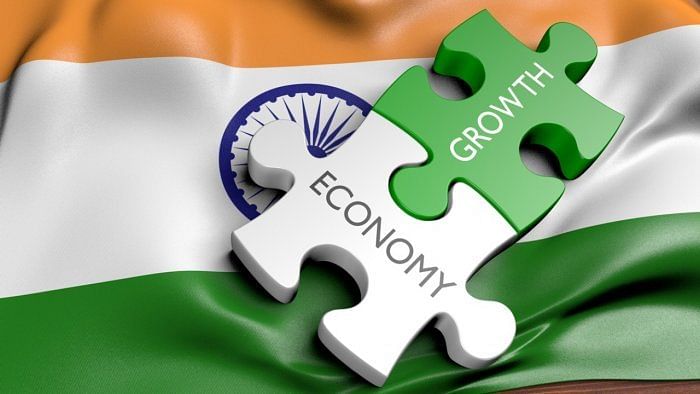
Earlier this month, the International Monetary Fund (IMF) reduced India’s potential growth rate over the medium term to around 6% per year. It was at 6.25% earlier. The IMF said this reflects “a more persistent impact from the pandemic.” “The lagged impact of the pandemic on corporate and financial sectors will likely contribute to lower investment…including in MSMEs,” it added.
The potential growth rate is the rate at which an economy can grow without leading to high inflation.
While Covid has had a significant negative impact, the Indian economy was already slowing down much before the pandemic struck. Growth had fallen to 3.3% in Oct-Dec 2019, having started on that path in early 2018.
Of course, if you live in Bengaluru and work for an IT outsourcing company or a start-up unicorn, you might be wondering, what’s this guy talking about. Let me just say, as the old cliché goes, there are always exceptions that prove the rule.
The larger point is, India has come a long way from the time when politicians, economists, analysts, fund managers, you and me, took a growth rate of 8-10% per year as a given. Now, we are talking about 6-7% as being very good. (Of course, growth in the current year is likely to be higher than 6%, but that is from the low base, indeed economic contraction by nearly 8%, of last year).
In percentage terms, the fall may not sound big, but it’s indeed a big deal. Consider this: In 2020, the Chinese GDP (in constant 2010 $) stood at $11.8 trillion; India’s was at $2.7 trillion. At a growth rate of 6% per year, India will take 25 years to get to where China was last year. If it grows at 10%, instead, it would get there in 15.5 years. That is the difference.
Of course, assuming that a country will grow at 6% per year over the next 25 years is itself a highly optimistic assumption to make. Such growth over a long period has been extremely rare in history. As Ruchir Sharma wrote in his 2013 book Breakout Nations, very few countries are able to grow at 5% or more over long periods. “Just six countries (Malaysia, Singapore, South Korea, Taiwan, Thailand, and Hong Kong) have maintained this rate of growth for four decades, and two (South Korea and Taiwan) have done so for five decades.”
Also, since 2013, India and China have also joined the list of countries that have achieved a growth of greater than 5% for a period of up to four decades. The interesting thing is that every decade has had its share of countries that were expected to be the next big thing and have then fallen by the wayside. As Sharma wrote: “In the 1960s, the Philippines, Sri Lanka, and Burma were billed as the next East Asian tigers, only to see their growth falter badly.”
The point is, even a 5% growth rate, let alone 8-10%, is difficult to sustain. Of course, IMF has predicted 6% per year for India. But remember, it is the potential, not a given.
As Lant Pritchett and Lawrence Summers wrote in a 2014 paper titled Asiaphoria meets regression to the mean: “Episodes of super-rapid growth (> 6%) tend to be extremely short-lived.” China’s massive growth, they say, is the exception to the rule. “So, China’s experience from 1977 to 2010 already holds the distinction of being the only instance, quite possibly in the history of mankind, but certainly in the data, with a sustained episode of super-rapid growth for more than 32 years.”
Chinese growth has slowed down since 2010. It was 2.3% in 2020 and 5.95% in 2019. The days of double-digit growth rates are past. In fact, a good portion of Chinese growth since 2010 has come through the expansion of the real estate sector, accompanied by people speculating in it.
As Thomas Orik wrote in China—The Bubble That Never Pops: “For China’s government, real estate is the ballast that keeps the economic ship afloat.” An estimate made by economists Kenneth Rogoff and Yuanchen Yang in an August 2020 working paper suggested that the real estate sector contributes around 29% of the Chinese GDP.
While this has kept the growth going, things have now reached a stage where the Chinese real estate sector is in deep trouble because of over-lending, and will possibly have to be rescued by the government.
Hence, economic growth is not a given. History tells us that very clearly, and we need to respect that. Also, one point that experts keep harping is that India has favourable population demographics with a fairly young population and this is good for economic growth.
Nevertheless, as Ruchir Sharma reminded us in The 10 Rules of Successful Nations: “Good demographics are often a necessary condition for rapid growth, but never a sufficient condition. The “dividend” pays off only if political leaders create the environment necessary to attract investment and generate jobs.”
As he further pointed out: “India, too, had assumed that its booming population would provide a demographic dividend, but now it struggles to generate jobs for all its youth.”
And that’s the long and short of it.